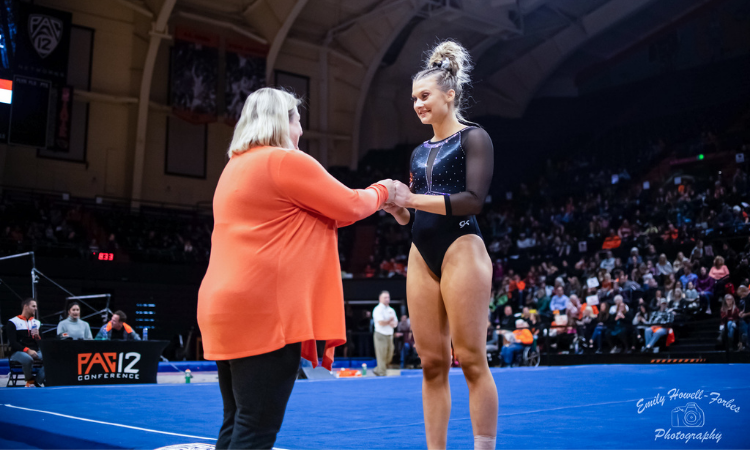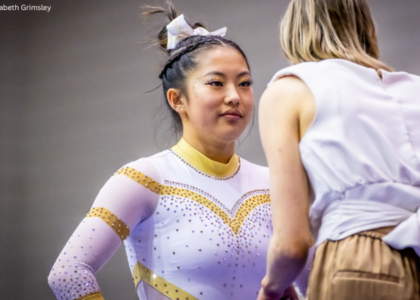There are a lot of ways to discuss success in coaching, but they’re often very subjective in gymnastics since we can’t rely on win/loss records the way other sports do. While we could use win/loss, it would be largely meaningless. Instead, we chose to dig into coaching success in major conference teams by change in NQS over the coaches’ tenures since it is the most tangible piece of data we have.
We broke coaches from major conferences—Big Ten, Big 12, Pac-12 and SEC—into four major groups: those whose coaches’ tenures have lasted one to four seasons, those that have lasted five to eight seasons, those that have lasted nine to 12 seasons and those that have lasted more than 12 seasons.
Within those groupings, we looked at several measures of NQS change over time, examining each head coach’s tenure.* We looked at final NQS numbers from the end of each regular season to avoid different scoring standards in the postseason, like bigger judging panels.
- Difference: The change in NQS from the coach’s first season to the 2022 season.
- % change: The percent change in NQS from the coach’s first season to the 2022 season.
- Career average: The team’s average NQS under the head coach.
- Trendline slope: The trendline is a line of best-fit for all data points. Trendline slope refers to the slope of that line. Zero would represent a flat, horizontal line. 1.00 would indicate a vertical line. A number closer to 1.00 indicates a team that has shown more improvement season to season while a negative number would indicate a team that has seen its NQS decrease season to season.
- Trendline R^2: R-squared indicates the level of variance in the same trendline as described in trendline slope. This value indicates the distance of data points off of the line of best fit. In this analysis, that means this value indicates how many NQS scores are much higher or much lower than the line of best fit. A number close to 1.0 means all of the NQS values are close to the trendline while a number closer to zero means the NQS values fall further away from the line.
*Note that we used RTN data, which only goes back to 1998. Bev Plocki has been at the helm for Michigan since 1990, but we only examined data dating to 1998. No other coach has a tenure beginning before 1998. We did not include Washington’s Jen Llewellyn since she has only coached one year. Chris Waller and Dana Duckworth, who are no longer with their respective teams, are included.
An asterisk next to a coach’s name indicates the coach has won a national title with their team.
More Than 12 Years as Head Coach
In the group of longest tenured head coaches includes the only two active coaches with national titles in Plocki and KJ Kindler. Kindler owns the highest overall average NQS, as well as the best consistency per the R-squared analysis. Tanya Chaplin’s Beavers had the best 2022 relative to her first year at the helm in 1998 while Larissa Libby owns the steepest trendline slope.
| Coach | Team | Since | Difference | Rank | Percent Change | Rank | Career Average | Rank | Trendline Slope | Rank | Trendline R^2 | Rank |
| Bev Plocki* | Michigan | 1990 | 1.402 | 6 | 0.71% | 6 | 196.8883 | 2 | 0.0388 | 7 | 0.3039 | 7 |
| Tanya Chaplin | Oregon State | 1998 | 2.517 | 1 | 1.29% | 1 | 196.3951 | 3 | 0.0571 | 6 | 0.4458 | 6 |
| Melissa Kutcher-Rinehart | Denver | 1999 | 1.541 | 5 | 0.79% | 5 | 196.1939 | 4 | 0.0811 | 5 | 0.6157 | 4 |
| Larissa Libby | Iowa | 2005 | 2.45 | 2 | 1.26% | 2 | 195.4709 | 7 | 0.1443 | 1 | 0.7432 | 2 |
| KJ Kindler* | Oklahoma | 2007 | 1.805 | 4 | 0.92% | 4 | 197.5059 | 1 | 0.1291 | 2 | 0.8421 | 1 |
| Jay Ronayne | Iowa State | 2007 | 0.575 | 7 | 0.29% | 7 | 195.6769 | 5 | 0.0849 | 4 | 0.5007 | 5 |
| Brett Nelligan | Maryland | 2010 | 2.125 | 3 | 1.09% | 3 | 195.5514 | 6 | 0.1234 | 3 | 0.7363 | 3 |
9 to 12 Years as Head Coach
This group of five coaches features up-and-comers in the SEC in Auburn, Kentucky and Missouri. Cal’s Howells (counted from when Justin was named head coach), own the best average NQS while SEC Coach of the Year Shannon Welker showed the best improvement from his first season to 2022—as well as the steepest trendline—followed by Auburn’s Jeff Graba.
| Coach | Team | Since | Difference | Rank | Percent Change | Rank | Career Average | Rank | Trendline Slope | Rank | Trendline R^2 | Rank |
| Jeff Graba | Auburn | 2011 | 2.345 | 2 | 1.20% | 2 | 196.6008 | 2 | 0.1103 | 4 | 0.4469 | 5 |
| Jason Butts | West Virginia | 2012 | 1.05 | 5 | 0.54% | 5 | 195.7481 | 5 | 0.0757 | 5 | 0.5029 | 4 |
| Tim Garrison | Kentucky | 2012 | 1.76 | 4 | 0.90% | 4 | 196.4295 | 3 | 0.1730 | 3 | 0.8180 | 1 |
| Justin & Liz Crandall-Howell | California | 2013 | 1.99 | 3 | 1.02% | 3 | 196.6668 | 1 | 0.1905 | 2 | 0.8117 | 2 |
| Shannon Welker | Missouri | 2014 | 2.425 | 1 | 1.25% | 1 | 196.2571 | 4 | 0.2086 | 1 | 0.7111 | 3 |
5 to 8 Years as Head Coach
This group is the largest and features those part of the huge coaching shakeup preceding the 2018 season. This is the first group with a few negative trendline slopes in Tabitha Yim, Sarah Brown and Courtney Kupets-Carter. Note that Yim’s calculations include the year-end 193.394 NQS from Stanford’s abbreviated 2021 season. Similarly, Mike Rowe’s numbers include a nil value in 2021 since Michigan State competed only twice that year. Still, Rowe’s Spartans have shown the greatest improvement from his first year to 2022, as well as the steepest trendline and closest fit in R-squared analysis.
| Coach | Team | Since | Difference | Rank | Percent Change | Rank | Career Average | Rank | Trendline Slope | Rank | Trendline R^2 | Rank |
| Dana Duckworth | Alabama | 2015 | 0.3 | 10 | 0.15% | 10 | 197.3573 | 3 | 0.0231 | 9 | 0.0484 | 10 |
| Jenny Hansen | Minnesota | 2015 | 0.99 | 3 | 0.50% | 3 | 196.6758 | 5 | 0.2035 | 4 | 0.5486 | 5 |
| Jenny Rowland | Florida | 2016 | 0.34 | 8 | 0.17% | 8 | 197.7999 | 1 | 0.0781 | 7 | 0.4892 | 7 |
| Tom Farden | Utah | 2016 | 0.715 | 4 | 0.36% | 4 | 197.5401 | 2 | 0.0747 | 8 | 0.5983 | 4 |
| Jay & Jess Santos | Arizona State | 2017 | 1.76 | 2 | 0.90% | 2 | 196.3947 | 6 | 0.2993 | 2 | 0.6721 | 3 |
| Nadalie Walsh | Illinois | 2018 | 0.51 | 7 | 0.26% | 7 | 196.3416 | 7 | 0.2078 | 3 | 0.4962 | 6 |
| Mike Rowe | MSU | 2018 | 2.32 | 1 | 1.19% | 1 | 195.7550 | 11 | 0.5920 | 1 | 0.9862 | 1 |
| Meredith Paulicivic | Ohio State | 2018 | 0.675 | 5 | 0.34% | 5 | 196.1778 | 8 | 0.1554 | 5 | 0.2750 | 8 |
| Sarah Brown | Penn State | 2018 | 0.075 | 11 | 0.04% | 11 | 195.9576 | 9 | -0.0107 | 10 | 0.0211 | 12 |
| Tabitha Yim | Stanford | 2018 | 0.335 | 9 | 0.17% | 9 | 195.5748 | 12 | -0.1931 | 12 | 0.0615 | 9 |
| Courtney Kupets Carter | Georgia | 2018 | 0.06 | 12 | 0.03% | 12 | 196.8172 | 4 | -0.0414 | 11 | 0.0422 | 11 |
| John Court | Arizona | 2018 | 0.65 | 6 | 0.33% | 6 | 195.8802 | 10 | 0.1381 | 6 | 0.6821 | 2 |
1 to 4 Years as Head Coach
The most junior head coaches include some of the biggest names on the list. Chris Waller and Heather Brink are the only coaches we examined whose 2022 NQS was lower than their first-year NQS, hence the negative difference, percent change and trendline slope values. Umme Salim-Beasley stands out in this group for showing the greatest improvement by every metric; Rutgers only doesn’t come first here in career average, a number owned by Jay Clark. His LSU squad also lands in second by most metrics.
| Coach | Team | Since | Difference | Rank | Percent Change | Rank | Career Average | Rank | Trendline Slope | Rank | Trendline R^2 | Rank |
| Umme Salim-Beasley | Rutgers | 2019 | 0.96 | 1 | 0.49% | 1 | 195.2988 | 5 | 0.3395 | 1 | 0.9588 | 1 |
| Heather Brink | Nebraska | 2019 | -0.57 | 5 | -0.29% | 5 | 196.2208 | 4 | -0.2437 | 5 | 0.5823 | 4 |
| Jordyn Wieber | Arkansas | 2020 | 0.335 | 3 | 0.17% | 3 | 196.8433 | 3 | 0.1675 | 3 | 0.2043 | 5 |
| Chris Waller | UCLA | 2020 | -0.475 | 4 | -0.24% | 4 | 197.2310 | 2 | -0.2375 | 4 | 0.6688 | 2 |
| Jay Clark | LSU | 2020 | 0.45 | 2 | 0.23% | 2 | 197.6110 | 1 | 0.2250 | 2 | 0.6232 | 3 |
READ THIS NEXT: Data Deep Dive: Most Impactful Transfers Since 2011
Data analysis by Mariah Dawson; article by Emily Minehart
Like what you see? Consider donating to support our efforts throughout the year!





One comment